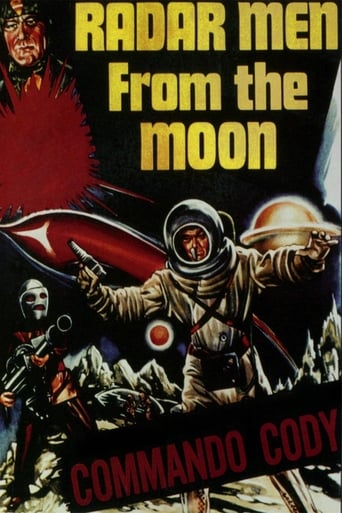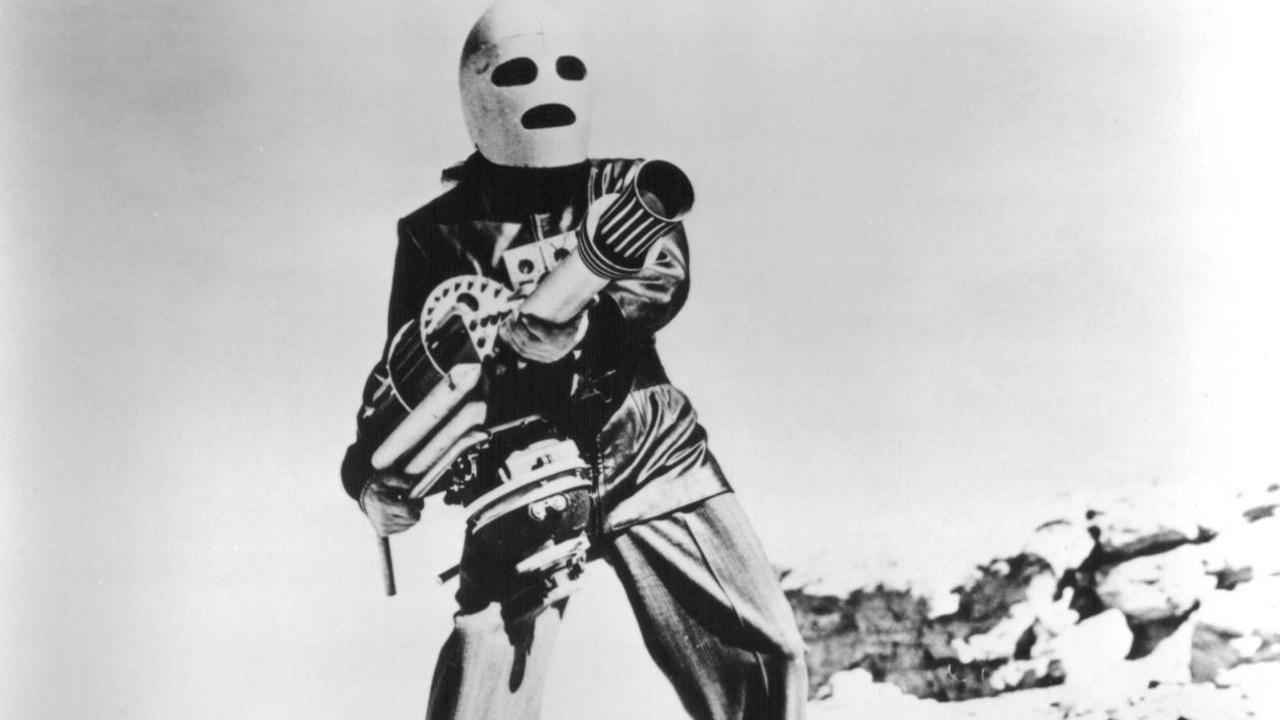wbswetnam
The movie theater serial "Radar Men from the Moon" is a 12 episode action series, each episode of which lasts about 10 minutes I think. The basic plot is that a dying civilization on the moon wishes to take over the Earth, so they begin their preparations by sending a small advance guard to cause mayhem on our planet before the full-scale invasion. The US government assigns Captain Cody and his rocket pack to stop the evil henchmen before they can proceed further.The dialog is kept to a minimum since this is an action series intended for the 7 to 13 year old crowd (those children are in their late 60s to early 70s now - scary thought) and it is pretty much one action scene after another. The cliffhangers at the end of each episode are miraculously resolved at the beginning of the next episode as the hero Commander Cody works a plan to outwit the moonmen and their evil earthling co-conspirators. Overall not a bad adventure series actually in my opinion, considering the limited budget and the limits on special effects at the time... they certainly didn't have computer graphics to insert back then.But why "Radarmen" in the title? I don't remember seeing any radars. There are some ray guns and moonmen and spaceships and rocketpacks, but no radars. Hmmm... go figure.
flapdoodle64
(Or: 'Republic Recycles Rocket Man') In 1949, in one of their last bursts of inspiration, the thrill engineers at Republic produced 'King of the Rocket Men,' which capitalized on the popularity of the flying hero Superman, from the eponymous 1948 Columbia film serial. Although Rocket Man flew, he was in fact an ordinary human scientist who happened to have a helmet and rocket pack, and who battled the terrorist Dr. Vulcan.King of the Rocketmen premiered 6-8-1949...3 weeks later, on 6-27-1949, the DuMont TV network premiered Captain Video, another science fiction hero who became one of the 1st bona fide superstars of early TV. After Rocket Man and Capt. Video, a number of science fiction heroes were popular on TV up through about 1955, when other trends began to dominate.Capt. Video's creators had been inspired by the movie serials. In turn, Columbia Pictures obtained the rights to the Capt. Video character, and produced the super-cheap but super-profitable 'Captain Video Master of the Stratosphere' serial. During this craze for quasi-military science-fiction heroes, Republic re-purposed the splendid Rocket Man flying footage and mixed in additional stock footage from about a dozen other serials to create Commando Cody. The name Commando Cody, BTW, was surely designed to capitalize on the popular TV character 'Commander Cory', of the hit TV series 'Space Patrol.' Thus it came to be that Republic was in the position of trying, late in the game, to jump aboard a trend that it inadvertently helped create! (But by the end of 1956, both the movie serials and the TV space heroes would be gone forever!)One of the ways you can identify the re-used footage is when people in 1952 suddenly all hop into 1938 or 1946 automobiles for a car chase. You have to remember, cars from this era were fortunate to last 50,000 miles, so the idea that the streets of downtown Los Angeles of 1952 are suddenly filled with 1938 cars is not plausible. I lost track of how many times the characters all jumped into these automotive anachronisms...Recylcing old footage is not necessarily a crime...in fact, some of Republic's best serials featured loads of reused material. But this serial shows a seriously uninspired writer, and it all seems kind of forced. Not to mention, Rettik the Moon Man is not a particularly menacing villain, with the other Moon Men and their Earth gangster stooges also lacking in menace and brain power. The Moon Scenes are pretty bad, even when compared with the stuff from Flash Gordon, and there is not a lot of emotional energy.George Wallace is physically unimpressive as the titular hero, but in the action scenes he does a surprisingly good job of conveying urgency. He is actually OK, as are his companions.Probably the best performance is by Clayton Moore, as one of the Earth gangsters inexplicably selling out his own planet for chump change. The performance is fun for everyone who saw his Lone Ranger performances and wondered what the guy actually looked like...well, here he is, and a he's a good actor, it turns out.There are plenty of fight scenes, but nothing as inspired as the stuff from the early 1940's. Worst of all, the final chapter resolves the conflict without Our Hero getting into a suitable physical confrontation with the villain. This is rather unsatisfying.By 1952, serials were fading fast, in terms of popularity and quality. This one is typical for that era. There are 2 other Rocket Man serials besides this one, the aforementioned 'King of the Rocket Men,' and 'Zombies of the Stratosphere.' Both King and Zombies are superior this serial, although this serial is an amiable waste of time.The great Lydecker Brothers created some new FX for this serial, some nice shots of a rocket ship taking off and flying...these shots were reused in Zombies, as well as being used in the amazingly strange Republic quasi-TV series 'Commando Cody, Sky Marshall of the Universe.'
keith-moyes-656-481491
When I was a young child in the mid-Fifties, I saw episodes from a number of serials and they made a stronger impression on me than any of the feature films I saw at that time. Certain images have been imprinted on my memory ever since: the whining spaceships spiralling to earth, the Clay Men oozing from the cave walls and the pointy-headed Rock Men in Flash Gordon; the golden scorpion with its crystal lenses being aligned to melt rock in The Adventures of Captain Marvell; and the rocket ships, space suits, robots and ray guns in Captain Video. As a result, I look on these serials with an affection that cannot be justified by any objective critical analysis.Radar Men from the Moon was not one I saw as a child and it isn't regarded as one of the best because it recycled too much material from earlier Republic serials. However, it has survived in an almost pristine print so it captures the look and feel of the classic serial better than most of the others that are still available today. What you see now is what it looked like then.Like other serials, it was intended primarily for young children and was made on a tight budget to a very strict formula. All the main plot elements are introduced in the first episode and the story then just chases round in circles for another 11 weeks. Each episode is essentially the same. It starts with the resolution of the previous week's cliff-hanger (usually an outrageous cheat) has five minutes of plot to set up this week's action and invariably features a fist fight, a chase and a new cliff-hanger. As was often the case with these serials, there is one chapter towards the end that merely re-caps previous events and reuses old footage.I don't want to pretend it is any better than it really is and I understand the negative responses of younger IMDb reviewers, but I must challenge some of their criticisms.Within the constraints of its budget and its formula it is not badly acted, it is not badly written and it is not badly directed. On the contrary, it is a highly efficient piece of film-making and many contemporary producers, actors, screenwriters and directors could benefit from studying its economy of means.Because it is intended for children, the characters are inevitably one-dimensional (the goodies are good and the baddies are bad) so all that is required of the actors is that they avoid the furniture and say the lines needed to set up the action sequences its young audiences had come to see. The acting in Radar Men may be minimal, but it is not bad: it is appropriate.Actors today feel they have to imbue every line in every dumb movie with maximum emotion: they glower and snarl; pause and hesitate; smoulder with barely-contained rage; their voices quiver with suppressed passion or drip with treacly sincerity. Unfortunately, people are so used to this scenery-chewing that if it isn't there they think nothing is happening on the screen at all.Because this type of acting is so common, we can no longer see how stylised and unreal it is. Show it to an audience from the Forties and they would probably howl with derision. Sometimes, the best thing an actor can do is just say the lines and let the situation supply the emotion. Less really is more.Nor is the dialogue in Radar Men bad. On the contrary, it is beautifully crafted to convey the maximum information in the minimum words. Few writers today could set up plot developments as economically as this.It is the same with the action sequences. Cars roar along roads and skid around corners and generate plenty of excitement. All that is required is to choose the right camera angles, cut in a few studio close ups, and speed up the film slightly. The fist fights just have good stunt men charging around the set, throwing punches and smashing chairs over each others' heads, while the camera sits there watching it. Today, sequences that Republic could knock off in an hour would take days to shoot. Every scene would require a dozen camera set ups and weeks of preparation by a stunt coordinator.I would also commend the special effects. The miniatures in Radar Men are generally pretty good (although the tabletop Lunar city is far too small), the full scale props are well constructed and highly evocative and the flying effects were not surpassed for decades.Today, CGI and animatronics enable producers to do things that Republic couldn't even dream of, but effects are often over-elaborate and over-used. We have lost sight of the simple truth that special effects are there to support the story, not dictate it.I am not proposing that movies should revert to the low ambitions or the poverty row budgets of these old serials. However, I do believe that the big action movies of today are often over-long, over-blown and over-the-top. Actors and directors take their simplistic characters too seriously. For example, comic book superheroes, designed for the amusement of eight-year-old boys, are treated as if they were characters in Greek tragedy. Every special effect, every action sequence, every stunt and every explosion has to be bigger and better than anything that has gone before, but to rapidly diminishing effect.Seeing how much Republic could achieve with minimal resources, in a serial like Radar Men, would be a useful corrective for many of today's film-makers who seem to think it's impossible to make an exciting action picture for under a hundred million dollars.In fact, I suspect the reverse is true. If budgets were routinely cut in half we would probably get better movies.
quamp
The Radar Men from the Moon is a pretty typical fare of 1950's serials. The special effects are pretty cheap, the lunar rovers are obviously World War II surplus jeeps with painted plywood over them, and the like. The acting is only so-so. It does inspire the imagination of children, to whom I believe this was directed to. By today's standards, it's boring, cheap, and bad. There's also a hefty amount of stock footage in the first 9 episodes of natural disasters.


 AD
AD



